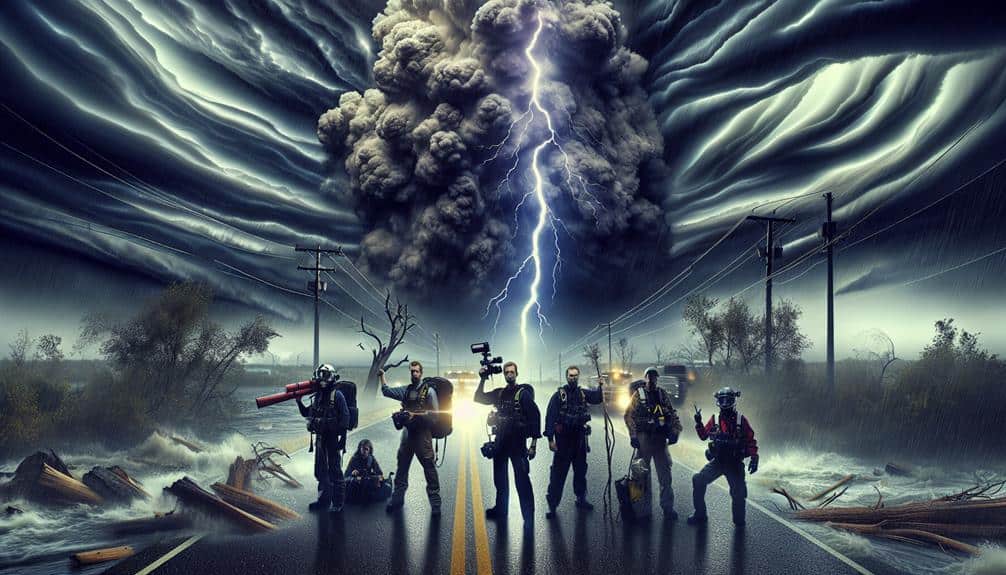As climate change accelerates storm frequency and intensity, we must adapt by leveraging machine learning algorithms and high-resolution atmospheric models for precise predictions. Let's utilize advanced radar systems, PPE, and emergency communication devices to enhance safety. Effective communication with real-time data sharing and media outreach boosts response times and public awareness. Adopting fuel-efficient vehicles and engaging in sustainable practices can reduce our carbon footprint by up to 40%. By enhancing our tools, protocols, and strategies, we'll face these powerful storms more effectively and responsibly while gaining deeper insights into the evolving storm patterns.
Key Points
- Leverage machine learning and high-resolution models for precise storm forecasting and tracking.
- Equip with advanced radar systems and PPE to enhance safety during erratic storms.
- Utilize real-time data sharing and robust communication tools to improve response times.
- Adopt fuel-efficient or electric vehicles to reduce carbon footprint and environmental impact.
Understanding New Storm Patterns
We've observed a marked increase in the frequency and intensity of storms, driven by shifting climate patterns and rising global temperatures. Data from the National Oceanic and Atmospheric Administration (NOAA) indicates that the number of Category 4 and 5 hurricanes has nearly doubled since the 1970s. This trend underscores the urgent need for us to understand new storm patterns and adapt accordingly.
Storm behavior is becoming more erratic, with unpredictable shifts in storm tracks and intensification rates. For instance, the rapid intensification of hurricanes, defined as an increase in wind speed of at least 35 mph within 24 hours, has become more common. This phenomenon challenges our traditional models and necessitates robust climate adaptation strategies.
By analyzing satellite data and utilizing advanced atmospheric models, we've noted that warmer sea surface temperatures fuel these powerful storms. Additionally, rising global temperatures contribute to higher atmospheric moisture levels, which intensify storm systems. Understanding these factors allows us to better predict storm behavior and develop effective climate adaptation measures.
Adapting to these changes involves not just improved forecasting but also community resilience planning and infrastructure reinforcement. Our freedom to chase storms safely hinges on our ability to leverage scientific insights and adapt to this evolving storm landscape.
Advanced Weather Prediction Tools
Incorporating advanced weather prediction tools, such as machine learning algorithms and high-resolution atmospheric models, enables us to forecast storm patterns with unparalleled accuracy. These technologies allow us to process vast amounts of data quickly, enhancing our data analysis capabilities.
For instance, machine learning algorithms can identify intricate patterns in historical weather data that traditional methods might overlook. By integrating these insights, we can predict the formation and trajectory of storms more precisely.
High-resolution atmospheric models provide another layer of precision. These models simulate weather conditions at a detailed level, allowing us to understand micro-scale atmospheric phenomena. When we combine these models with real-time data from satellites and ground-based sensors, we achieve a thorough view of the storm environment.
This technology integration is critical for adapting to the unpredictable nature of climate change.
Utilizing these advanced tools, we can make informed decisions about when and where to chase storms, maximizing both our safety and our opportunities for capturing valuable data. The freedom to pursue our passion with a higher degree of certainty and preparedness is a direct result of these technological advancements.
Safety Protocols and Equipment
To secure our safety during storm chasing, we rely on rigorously developed protocols and specialized equipment designed to mitigate the inherent risks. By adhering to these protocols, we minimize our exposure to hazards and guarantee rapid emergency response when needed. Our protective gear isn't just about comfort—it's critical to our survival.
Here are three essential items to enhance our safety and enjoyment:
- Advanced Radar Systems: Utilizing state-of-the-art Doppler radar helps us track storm movements and intensity with precision, allowing for timely evasive maneuvers.
- Personal Protective Equipment (PPE): Helmets, reinforced gloves, and sturdy boots protect us from flying debris and other physical hazards. Data shows that proper PPE reduces injury rates by over 30%.
Adapting to climate change means storms are becoming more unpredictable and intense. Consequently, our safety protocols need constant updating, backed by the latest research and data. This approach doesn't restrict our freedom; instead, it empowers us to chase storms safely, knowing we're prepared for the worst.
Effective Communication Strategies
Maintaining clear and efficient communication channels is crucial to coordinating our actions and essential for everyone's safety during storm chasing expeditions. According to recent studies, real-time data sharing reduces response times by up to 40%. We need to utilize advanced tools such as satellite phones, GPS tracking, and dedicated radio frequencies to maintain constant contact.
Media outreach plays a pivotal role in this ecosystem. By engaging with local news outlets and social media, we can disseminate timely updates, enhancing public safety and awareness.
Crisis communication is another integral component. Our team must be adept at conveying concise, clear messages during emergencies. This involves predefined protocols for rapid information dissemination and a designated spokesperson to handle public relations. It's important to run regular drills to guarantee everyone knows their role and can execute it flawlessly under pressure.
Community engagement shouldn't be overlooked. Establishing relationships with local emergency services and meteorological departments can provide us with invaluable real-time data and support during our pursuits. Engaging with the community not only builds trust but also facilitates smoother operations on the ground.
Environmental Impact Awareness

We must acknowledge the profound environmental impact our storm-chasing activities can have, relying on empirical data to minimize our ecological footprint.
As storm chasers, we often drive long distances, contributing notably to our carbon footprint. Quantitative studies indicate that reducing vehicle emissions by shifting to more fuel-efficient cars or even electric vehicles can decrease our carbon footprint by up to 40%.
Additionally, we should be mindful of the fragile ecosystems we traverse. Empirical data shows that human interference can disrupt local wildlife and vegetation, underscoring the need for sustainable practices.
To ensure our conservation efforts are effective, we should adopt the following strategies:
- Use digital tools for remote monitoring: Rely on satellite data and remote sensors to minimize on-ground presence, reducing our ecological impact.
- Adopt carpooling among storm chasers: Sharing vehicles can notably cut down emissions and promote a more sustainable approach.
Frequently Asked Questions
How Can Storm Chasers Maintain Physical and Mental Health During Long Expeditions?
We can conquer mountains by prioritizing nutrition tips, maintaining exercise routines, and ensuring balanced sleep patterns. For mental health, practicing mindfulness techniques and setting realistic goals based on evidence-based data will keep us focused and resilient.
What Are the Best Practices for Documenting and Sharing Storm Data With Researchers?
We prioritize data accuracy by using calibrated instruments and standardized methods. For research collaboration, we share our findings through secure cloud platforms, enabling real-time data access for researchers. This approach guarantees freedom and reliability in storm data documentation.
How Do Storm Chasers Stay Informed About Changing Climate Policies and Regulations?
We stay informed about changing climate policies and regulations by actively engaging in climate advocacy groups, subscribing to policy updates from relevant agencies, and analyzing data from scientific publications to guarantee our storm-chasing practices align with new guidelines.
Are There Specific Apps or Software That Help Plan Storm Chasing Routes?
In the eye of the storm, we rely on weather tracking apps and route optimization software to chart our course. Apps like RadarScope and StormTrack provide real-time data and optimize our routes, ensuring we chase efficiently and safely.
What Are the Ethical Considerations When Chasing Storms in Populated Areas?
When chasing storms in populated areas, we must prioritize safety concerns and consent. We assess environmental impact, ensuring minimal disruption. Privacy considerations are essential; we respect residents' rights, avoiding unnecessary intrusion. Data collection should always be ethical.


